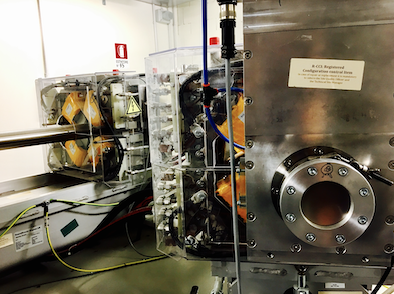Preliminary Programme
1st Trento Proton Beam Line Workshop 9th November 2020
9:00-9:30 Introduction
9:30-10:30 Detectors – First Session
Contributions:
- R. Catalano (INFN-Laboratori Nazionali del Sud), Scintillator-based system for transversal dose profile reconstruction for clinical proton beams
- V. D’Avino (INFN Napoli), Thermoluminescent dosimeters (TLD-100) performance in high-energy proton beam line
- S.M. Carturan (INFN-Laboratori Nazionali di Legnaro), Responsivity and radiation hardness of siloxane-based scintillators as indirect sensors in the FIRE project under 37 MeV H+ irradiation @TIFPA center
- B. Fraboni (Università di Bologna and INFN Bologna), Direct Detection of MeV Protons by Flexible Organic
Thin Film Devices - M. Missiaggia (Università di Trento and Trento Institute for Fundamental Physics and Applications-TIFPA), A novel Hybrid Detector design for Microdosimetry applications: HDM
10:30-10:45 Break
10:45-11:30 Detectors – Second Session
Contributions:
- G. Silvestre (INFN Perugia) , Qualification of microstrip silicon sensors @ TIFPA proton beam
- Y. Dong (INFN Milano), Calibration of the drift chamber detector within the FOOT experiment
- M. Marafini (Università di Roma "La Sapienza" and INFN Roma), TOPS: Time Of flight Plastic Scintillators
- G. Traini (Università di Roma "La Sapienza" and INFN Roma), Dose Profiler and MONDO characterisation with proton beams at the Trento proton beam line facility
11:30-12:30 Radiobiology & related applications
Contributions:
- A. Bisio (Università di Trento-Center for Integrative Biology (CIBIO)), The lack of p21 sensitizes colon cancer cells to radiation-induced apoptosis
- G. Casati (Ospedale Pediatrico "Meyer"- Firenze), Preliminary results on biological effects and molecular alterations induced by combined proton-therapy and chemotherapy in high-grade glioma treatment
- G. Onorato (Università di Torino and Università della Campania), Development of C. elegans as a model for studying neurodegeneration in space-related conditions
- D. Boscolo (GSI Helmholtzzentrum für Schwerionenforschung), Oxygen depletion measurements for different media with energetic proton beams
- M. Würl (LMU Ludwig-Maximilians-Universität München), Development of a setup for small-animal proton imaging based on a miniaturized Timepix detector
12:30-13:30 Lunch Break
13:30-14:30 Medical Physics applications
Contributions:
- M. Scaringella (Università di Firenze), Results on proton Computed Tomography
- C. Civinini (INFN Firenze) , Proton therapy x-ray CT calibration by proton tomography
- O.A. Marti Villarreal (Università degli Studi di Torino and INFN Torino), *MoVeIT detectors characterization at Trento Proton Beam Line Facility
- G. Cartechini (Università di Trento and Trento Institute for Fundamental Physics and Applications-TIFPA), Enhancing prompt gammas production for online dose verification in proton therapy
- F. Fausti (DE.TEC.TOR. Devices & Technologies Torino S.r.l.), Experimental route to QEye, an innovative device for high-resolution range verification in ocular tumour treatments
14:30-14:45 Break
14:45-15:30 Space Applications
Contributions:
- F. Horst (GSI Helmholtzzentrum für Schwerionenforschung), Dosimetry Experiments from GSI for Therapy and Space Radiation Research at the Trento Proton Therapy Facility
- C. Schuy (GSI Helmholtzzentrum für Schwerionenforschung), Advanced solar particle event simulation at medical accelerators (CELESTIAL)
- L. Di Fino (Università di Roma "Tor Vergata"), Lidal calibration at TIFPA proton beam line
- G. Dilillo (Università di Udine and INFN Trieste), Radiation testing and space qualification of GAGG: Ce scintillator crystals for the HERMES project
15:30-15:45 Break
15:45-16:45 Round Table
16:45-17:00 Closing Remarks

